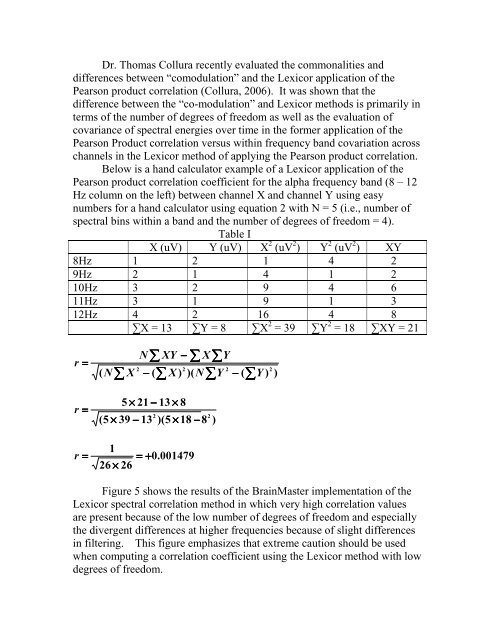EEG and Brain Connectivity: A Tutorial - Bio-Medical Instruments, Inc.
EEG and Brain Connectivity: A Tutorial - Bio-Medical Instruments, Inc.
EEG and Brain Connectivity: A Tutorial - Bio-Medical Instruments, Inc.
You also want an ePaper? Increase the reach of your titles
YUMPU automatically turns print PDFs into web optimized ePapers that Google loves.
Dr. Thomas Collura recently evaluated the commonalities <strong>and</strong><br />
differences between “comodulation” <strong>and</strong> the Lexicor application of the<br />
Pearson product correlation (Collura, 2006). It was shown that the<br />
difference between the “co-modulation” <strong>and</strong> Lexicor methods is primarily in<br />
terms of the number of degrees of freedom as well as the evaluation of<br />
covariance of spectral energies over time in the former application of the<br />
Pearson Product correlation versus within frequency b<strong>and</strong> covariation across<br />
channels in the Lexicor method of applying the Pearson product correlation.<br />
Below is a h<strong>and</strong> calculator example of a Lexicor application of the<br />
Pearson product correlation coefficient for the alpha frequency b<strong>and</strong> (8 – 12<br />
Hz column on the left) between channel X <strong>and</strong> channel Y using easy<br />
numbers for a h<strong>and</strong> calculator using equation 2 with N = 5 (i.e., number of<br />
spectral bins within a b<strong>and</strong> <strong>and</strong> the number of degrees of freedom = 4).<br />
Table I<br />
X (uV) Y (uV) X 2 (uV 2 ) Y 2 (uV 2 ) XY<br />
8Hz 1 2 1 4 2<br />
9Hz 2 1 4 1 2<br />
10Hz 3 2 9 4 6<br />
11Hz 3 1 9 1 3<br />
12Hz 4 2 16 4 8<br />
∑X = 13 ∑Y = 8 ∑X 2 = 39 ∑Y 2 = 18 ∑XY = 21<br />
r<br />
r<br />
=<br />
=<br />
( N<br />
N∑ XY − ∑ X∑Y<br />
2<br />
2<br />
2<br />
∑ X − ( ∑ X ) )( N∑Y<br />
− ( ∑<br />
5 × 21 − 13 × 8<br />
2<br />
2<br />
(5 × 39 − 13 )(5 × 18 −8<br />
)<br />
Y )<br />
2<br />
)<br />
r<br />
=<br />
1<br />
26 × 26<br />
= + 0.001479<br />
Figure 5 shows the results of the <strong>Brain</strong>Master implementation of the<br />
Lexicor spectral correlation method in which very high correlation values<br />
are present because of the low number of degrees of freedom <strong>and</strong> especially<br />
the divergent differences at higher frequencies because of slight differences<br />
in filtering. This figure emphasizes that extreme caution should be used<br />
when computing a correlation coefficient using the Lexicor method with low<br />
degrees of freedom.
















